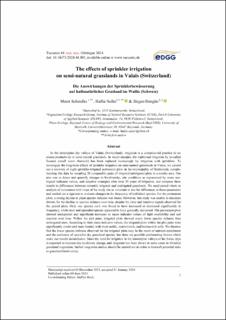Please use this identifier to cite or link to this item:
https://doi.org/10.21256/zhaw-31057Full metadata record
| DC Field | Value | Language |
|---|---|---|
| dc.contributor.author | Schindler, Meret | - |
| dc.contributor.author | Seiler, Hallie | - |
| dc.contributor.author | Dengler, Jürgen | - |
| dc.date.accessioned | 2024-07-12T08:35:47Z | - |
| dc.date.available | 2024-07-12T08:35:47Z | - |
| dc.date.issued | 2024-06-04 | - |
| dc.identifier.issn | 0722-494X | de_CH |
| dc.identifier.issn | 0373-7632 | de_CH |
| dc.identifier.uri | https://digitalcollection.zhaw.ch/handle/11475/31057 | - |
| dc.description.abstract | In the inneralpine dry valleys of Valais (Switzerland), irrigation is a centuries-old practice to increase productivity in semi-natural grasslands. In recent decades, the traditional irrigation by so-called Suonen (small water channels) has been replaced increasingly by irrigation with sprinklers. To investigate the long-term effects of sprinkler irrigation on semi-natural grasslands in Valais, we carried out a resurvey of eight sprinkler-irrigated permanent plots in the municipality of Bettmeralp, complementing this data by sampling 20 comparable pairs of irrigated/unirrigated plots in a nearby area. Our aim was to detect and quantify changes in biodiversity, site conditions as represented by mean ecological indicator values, and adaptive strategies after over 30 years of irrigation, and compare these results to differences between currently irrigated and unirrigated grasslands. We used paired t-tests or analysis of covariance with slope of the study site as covariate to test for differences in these parameters and carried out a sign test to evaluate changes in the frequency of individual species. For the permanent plots, a strong decline in plant species richness was found. However, this study was unable to elucidate drivers for the decline in species richness over time, despite the clear and intuitive signals observed for the paired plots. Only one species each was found to have increased or decreased significantly in frequency, while rarer and specialist species appeared to have generally decreased. The permanent plots showed unexpected and significant increases in mean indicator values of light availability and soil reaction over time. Within the plot pairs, irrigated plots showed much lower species richness than unirrigated ones. According to their mean indicator values, the irrigated plots within the plot pairs were significantly cooler and more humid, with more acidic, nutrient-rich, and humus-rich soils. We theorize that the lower species richness observed for the irrigated plots may be the result of nutrient enrichment and the exclusion of specialist dry grassland species, but there are possible confounding factors which make our results inconclusive. Since the need for irrigation in the inneralpine valleys of the Swiss Alps is expected to increase due to climate change, and irrigation has been shown in some cases to trivialize grassland vegetation, further long-term studies should be carried out in order to forestall potential risks to grassland biodiversity. | de_CH |
| dc.language.iso | en | de_CH |
| dc.publisher | Floristisch-Soziologische Arbeitsgemeinschaft | de_CH |
| dc.relation.ispartof | Tuexenia | de_CH |
| dc.rights | https://creativecommons.org/licenses/by/4.0/ | de_CH |
| dc.subject | Biodiversity | de_CH |
| dc.subject | CSR strategy | de_CH |
| dc.subject | Ecological indicator value | de_CH |
| dc.subject | Inneralpine dry valley | de_CH |
| dc.subject | Resurvey | de_CH |
| dc.subject | Semi-natural grassland | de_CH |
| dc.subject | Sprinkler irrigation | de_CH |
| dc.subject | Switzerland | de_CH |
| dc.subject | Vegetation change | de_CH |
| dc.subject.ddc | 333.7: Landflächen, Naturerholungsgebiete | de_CH |
| dc.subject.ddc | 577: Ökologie | de_CH |
| dc.title | The effects of sprinkler irrigation on semi-natural grasslands in Valais (Switzerland) | de_CH |
| dc.type | Beitrag in wissenschaftlicher Zeitschrift | de_CH |
| dcterms.type | Text | de_CH |
| zhaw.departement | Life Sciences und Facility Management | de_CH |
| zhaw.organisationalunit | Institut für Umwelt und Natürliche Ressourcen (IUNR) | de_CH |
| dc.identifier.doi | 10.14471/2024.44.001 | de_CH |
| dc.identifier.doi | 10.21256/zhaw-31057 | - |
| zhaw.funding.eu | No | de_CH |
| zhaw.originated.zhaw | Yes | de_CH |
| zhaw.publication.status | publishedVersion | de_CH |
| zhaw.volume | 44 | de_CH |
| zhaw.publication.review | Peer review (Publikation) | de_CH |
| zhaw.webfeed | Vegetationsökologie | de_CH |
| zhaw.author.additional | No | de_CH |
| zhaw.display.portrait | Yes | de_CH |
| Appears in collections: | Publikationen Life Sciences und Facility Management | |
Files in This Item:
| File | Description | Size | Format | |
|---|---|---|---|---|
| 2024_Schindler-etal_Sprinkler-irrigation-effects-Valais_Tuexenia.pdf | 2.53 MB | Adobe PDF |  View/Open |
Show simple item record
Schindler, M., Seiler, H., & Dengler, J. (2024). The effects of sprinkler irrigation on semi-natural grasslands in Valais (Switzerland). Tuexenia, 44. https://doi.org/10.14471/2024.44.001
Schindler, M., Seiler, H. and Dengler, J. (2024) ‘The effects of sprinkler irrigation on semi-natural grasslands in Valais (Switzerland)’, Tuexenia, 44. Available at: https://doi.org/10.14471/2024.44.001.
M. Schindler, H. Seiler, and J. Dengler, “The effects of sprinkler irrigation on semi-natural grasslands in Valais (Switzerland),” Tuexenia, vol. 44, Jun. 2024, doi: 10.14471/2024.44.001.
SCHINDLER, Meret, Hallie SEILER und Jürgen DENGLER, 2024. The effects of sprinkler irrigation on semi-natural grasslands in Valais (Switzerland). Tuexenia. 4 Juni 2024. Bd. 44. DOI 10.14471/2024.44.001
Schindler, Meret, Hallie Seiler, and Jürgen Dengler. 2024. “The Effects of Sprinkler Irrigation on Semi-Natural Grasslands in Valais (Switzerland).” Tuexenia 44 (June). https://doi.org/10.14471/2024.44.001.
Schindler, Meret, et al. “The Effects of Sprinkler Irrigation on Semi-Natural Grasslands in Valais (Switzerland).” Tuexenia, vol. 44, June 2024, https://doi.org/10.14471/2024.44.001.
Items in DSpace are protected by copyright, with all rights reserved, unless otherwise indicated.